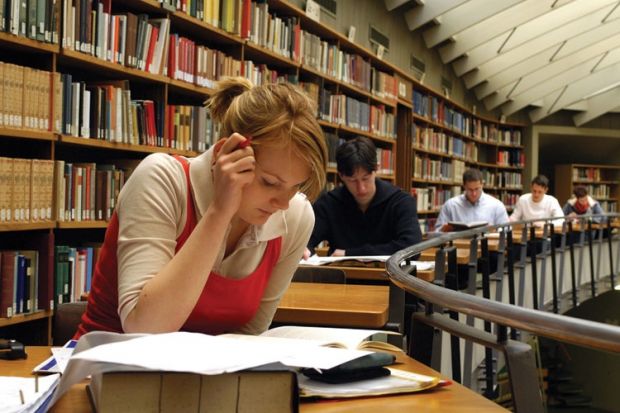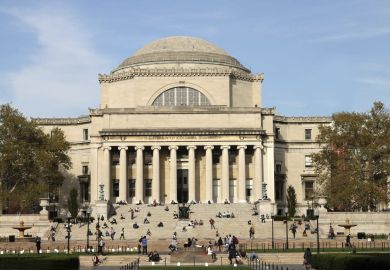Source: Alamy
Studying long and hard: a survey of students’ workloads revealed big variations between institutions
Concerns about the equivalence of degree standards have been heightened by a Times Higher Education analysis that shows large variations in student workloads between and within university mission groups.
The Academic Experience of Students in English Universities: 2013 Report, which was released in May and produced by Which? and the Higher Education Policy Institute, found big differences in student workloads between universities and across 13 subject areas, but did not generally name individual institutions.
But using a detailed breakdown of the 2012-13 survey data, THE has calculated the number of times universities from each mission group are either above or below the median average workload for each subject area in order to obtain a broad sense of where students are working the hardest.
Excluding the universities of Oxford and Cambridge, the Russell Group of research-intensive universities comes out on top, appearing above the average in subject workload tables 53.1 per cent of the time.
Next is the 1994 Group of smaller research-intensive institutions (47.4 per cent), followed by Million+ (45.2 per cent).
University Alliance members had above-average subject workloads less than one third of the time (there are not enough GuildHE institutions included in the data to analyse).
Post-1992 universities come bottom in 10 of the 13 subject tables. The lightest workload on any course is at Leeds Metropolitan University, where business and administration studies students work an average of 15.9 hours a week (9.9 scheduled hours plus six hours of private study).
Paul Smith, deputy vice-chancellor for strategic development, said that not all teaching time had been taken into account, the survey had sampled only a very small proportion of students and that nearly 90 per cent of business and administration students were in work or further study six months after graduation.
Responding to the mission group analysis, Steve West, chair of the University Alliance and vice-chancellor of the University of the West of England, pointed out that the survey did not include time spent in work placements and sandwich years, which he said were particular strengths of the group.
Pam Tatlow, chief executive of Million+, said: “The idea that modern universities, which usually have longer terms, require less application or work is a myth.”
Perhaps unsurprisingly, students at the universities of Oxford and Cambridge occupy the top two spots in every subject list where both institutions feature, bar medicine and dentistry.
Cambridge tops seven subject tables and Oxford two.
But despite this rough correlation between selectivity and workload, there are still major variations within the mission groups.
Click image below to enlarge

For example, students at the University of Sheffield, a Russell Group member, work below-average hours in eight of the nine subject areas in which the institution features.
Paul White, pro vice-chancellor for learning and teaching at Sheffield, said that the university’s priority was “quality not quantity”.
Stable data
A number of universities questioned the survey’s sample size and whether the results were reliable.
A spokeswoman for Which? said that it had included only responses with more than 20 results, and that during the past five years of the survey the data had proved stable, meaning that universities could be “confident in the findings”.
Bahram Bekhradnia, director of Hepi, said concerns that degrees were not of equal standard had been “heightened” by the THE analysis.
“One reason for believing that students who study less hard might obtain the same standard of qualification as others who study harder would be if they were better prepared in the first place. That is clearly not the case,” he said.
However, Mr Bekhradnia cautioned that it would be “positively misleading” to assume that a university would have high or low workloads just because it was in a particular mission group, as there was likely to be “as much variation within the groups as between them”.
The Which?/Hepi report found that different subjects have “very different” average amounts of study, ranging from nearly 40 hours a week for architecture, building and planning to around 23 hours for mass communications and documentation.
It also stresses that students are doing an average of 900 hours of work a year, a quarter fewer than the 1,200 hours assumed to be necessary for a degree by the Quality Assurance Agency.
Richard Lloyd, executive director of Which?, said that this discrepancy “raises questions over standards and whether students are being pushed hard enough”.
A spokeswoman for the QAA said it had been in discussions with Which? and Hepi about the report’s findings.
She added that it would release guidance on the issue this month, followed in the autumn by the publication of its research on “various aspects of the academic experience in higher education”.
Register to continue
Why register?
- Registration is free and only takes a moment
- Once registered, you can read 3 articles a month
- Sign up for our newsletter
Subscribe
Or subscribe for unlimited access to:
- Unlimited access to news, views, insights & reviews
- Digital editions
- Digital access to THE’s university and college rankings analysis
Already registered or a current subscriber? Login




